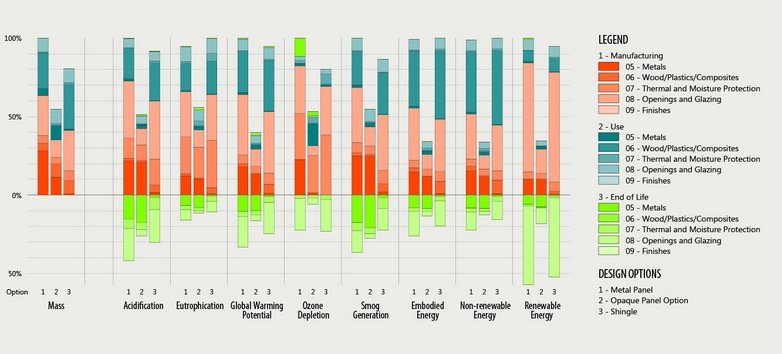Kieran Timberlake and PE International have developed Tally, a new analysis tool to help BIM users keep better score of their projects’ complete environmental footprints. When used alongside other critical studies like daylighting simulation and energy modeling, BIM tools like Tally can help construction professionals move towards data-driven analysis for whole building life cycle assessment, writes TriplePundit.com.
Kieran Timberlake explains Tally:
Quantifying environmental impact typically involves performing a Life Cycle Assessment, which is a relatively new and confounding practice for most architects. Currently, no efficient means exists to evaluate environmental impact of materials during the design and planning process, when it can have the most influence on design decisions and building performance. An architect needs this impact data at the time of material specification, but the laborious process required for calculating embodied environmental impact across a broad range of design decisions prevents this from happening at crucial moments in the design process.
In principle, Building Information Modeling (BIM) ought to enable architects to acquire this information, but in practice, projects are not modeled to a sufficient level of detail to account for all of the materials in a building at their actual volume. In order to address these challenges, we invented Tally™, a Revit app that allows users to imbue each assembly with information about the architectural products it contains. Tally™ quantifies embodied energy along with other environmental impacts and emissions to land, air, and water. It can be used for whole-building analysis or for comparative analyses of various design options, and it can account for the diverse range of material classes defined in a BIM model, as well as materials that are not modeled explicitly.
For more on Tally, visit: http://kierantimberlake.com/pages/view/95/tally/parent:4.
Related Stories
| Oct 5, 2011
GREENBUILD 2011: Brick offers growing options for sustainable building design
Brick exteriors, interiors and landscaping options can increase sustainability that also helps earn LEED certification.
| Oct 5, 2011
GREENBUILD 2011: Roof hatch designed for energy efficiency
The cover features a specially designed EPDM finger-type gasket that ensures a positive seal with the curb to reduce air permeability and ensure energy performance.
| Oct 4, 2011
GREENBUILD 2011
Click here for the latest news and products from Greenbuild 2011, Oct. 4-7, in Toronto.
| Oct 4, 2011
GREENBUILD 2011: Methods, impacts, and opportunities in the concrete building life cycle
Researchers at the Massachusetts Institute of Technology’s (MIT) Concrete Sustainability Hub conducted a life-cycle assessment (LCA) study to evaluate and improve the environmental impact and study how the “dual use” aspect of concrete.
| Oct 4, 2011
GREENBUILD 2011: Johnsonite features sustainable products
Products include rubber flooring tiles, treads, wall bases, and more.
| Oct 4, 2011
GREENBUILD 2011: Nearly seamless highly insulated glass curtain-wall system introduced
Low insulation value reflects value of entire curtain-wall system.
| Oct 4, 2011
GREENBUILD 2011: Ready-to-use wood primer unveiled
Maintains strong UV protection, clarity even with application of lighter, natural wood tones.
| Oct 4, 2011
GREENBUILD 2011: Two new recycled glass products announced
The two collections offer both larger and smaller particulates.
| Oct 4, 2011
GREENBUILD 2011: Mythic Paint launches two new paint products
A high performance paint, and a combination paint and primer now available.
















